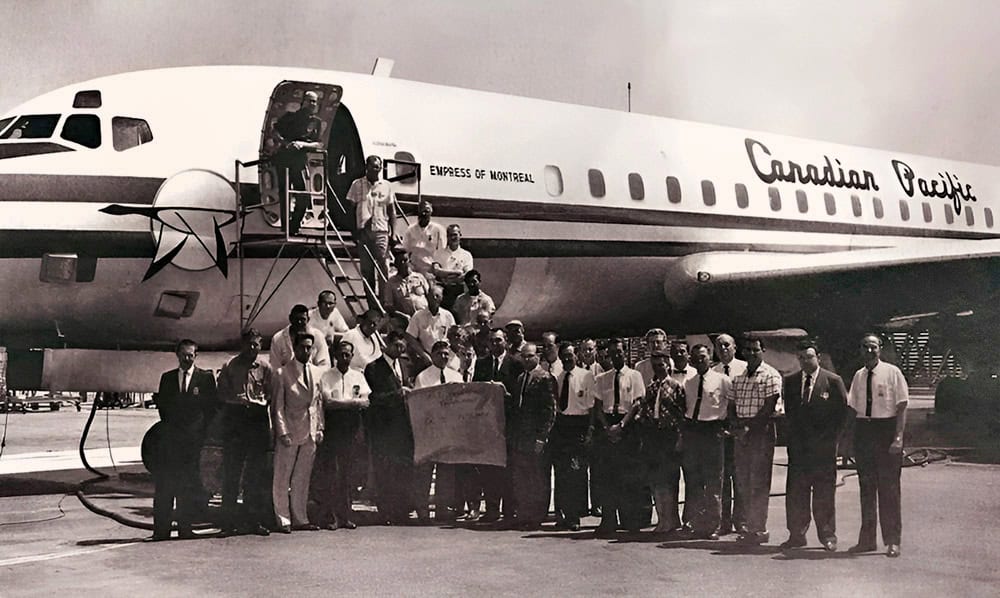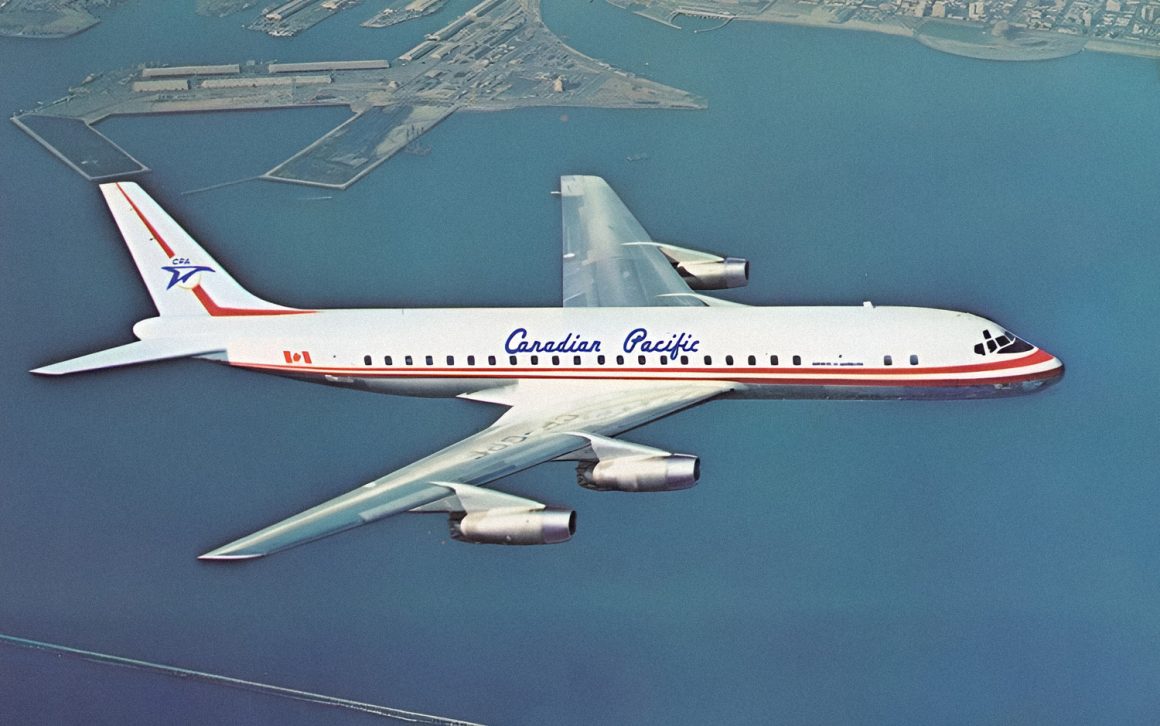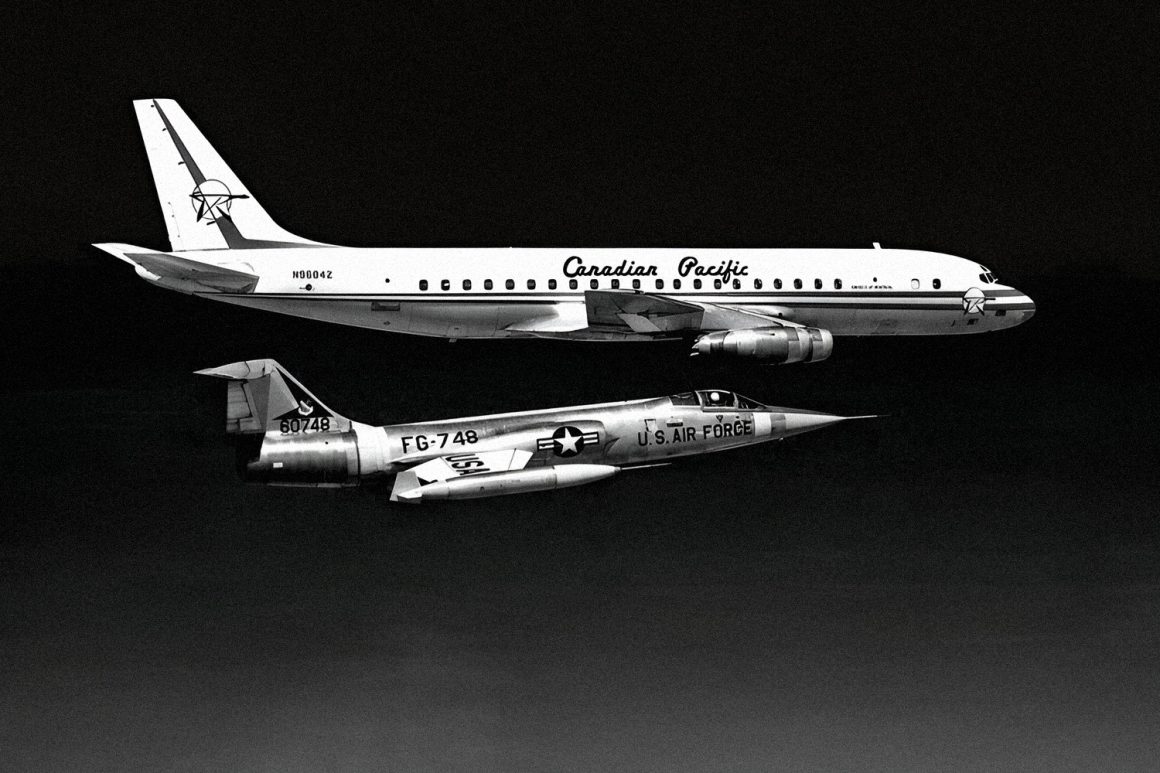A supersonic DC-8?! In 1961, high above the Nevada desert, pilot William Magruder made a unique mark on aviation history.
The Douglas DC-8 is an old narrowbody, heavy-lift airliner from the late 1950s, a contemporary of the Boeing 707. Some aviation enthusiasts today may not have heard of the type, and of those who have, some may not know what made the DC-8 unique among civilian airliners.
Daredevils and Researchers
Some of you may recall a guy known as ‘The Human Fly‘ who did a ‘wing-walking’ routine atop a DC-8 back in the 1970s. Rick Rojatt was a Canadian stuntman who billed himself as a real-life superhero. Rojatt’s ‘Human Fly’ routine inspired a Marvel Comics character of the same name.
To the best of your author’s knowledge, Rojatt was the only person to perform such a routine with such a large aircraft. Though singular, and not a bit wacky, this is not what made the DC-8 unique.

There’s something else that’s earned the DC-8 its place in aviation history. The type has long been retired from mainline service, with only one still flying today–a passenger/cargo combi aircraft operated by humanitarian organization Samaritan’s Purse. This example will be retired by the end of 2025, when it will be replaced with a Boeing 767.

The DC-8’s long-range and heavy-lift capabilities make it uniquely suitable for facilitating cargo missions to far-flung corners of the globe.
However, though this is highly interesting and unique in itself, it is not what makes the DC-8 truly unique.

A supersonic DC-8? Well, yes, for a few seconds
When thinking of supersonic travel… civilian travel… the first thing that comes to mind is the Concorde SST. Then maybe the Tupolev Tu-144, which was the Russian answer to the Concorde.
Surely, those are the only civil airliners to have pierced the sound barrier, yes?
No.
On 21 August 1961, Douglas test pilot William Magruder lifted DC-8 N9604Z off the runway at Edwards AFB. He then began a long, slow climb up to about 52,000 feet.
(Or 50,000, depending on which source you believe. Either way, this was a record in itself.)
From there, he made a half-G pushover and put the big bird into a dive. While passing through 45,000 feet, the jetliner cracked the sound barrier, maintaining Mach 1.01 for about 16 seconds.
A Scary Moment – And Quick Thinking
Recovery was a bit hairy. Magruder attempted to pull out of the dive but found the elevators ineffective. The stabilizers, too, would not work; their motors could not overcome the heavy loads that had built up in the pull-out.
Magruder then pushed over a bit more, and that lessened the load enough to allow the stabilizers to do their thing.
He was finally able to recover at about 35,000 feet and headed back down to a landing at Edwards. There, a slight bit of pomp and ceremony awaited him.

The Jet That Made the DC-8 Unique
The aircraft used for the record-setting flight was a DC-8-43 built for Canadian Pacific Airlines and dubbed Empress of Montreal.
While flown in the USA prior to delivery, the jet carried the US civil registration N9604Z. However, she was given the Canadian registration CF-CPG upon delivery to Canadian Pacific.
The jet went on to serve with Canadian Pacific (later renamed CP Air) until 1974. After that, she was passed to another couple’a outfits, and finally sold for scrap in 1980.

A Unique Achievement, all in the Name of Marketing
The whole thing was basically a glorified publicity stunt. Douglas was competing with Boeing in the civil jet airliner market, pitting the DC-8 against the 707.
During testing, the DC-8 achieved .97 Mach, and Magruder figured they could go past Mach 1 without a problem.
Why not, right? In any sort of competition, you want to demonstrate superiority over your competitors. Even if only for bragging rights.
So the objective of this flight was to demonstrate that “the airplane can survive this and not fall apart,” as Magruder’s flight engineer Richard Edwards put it.

A couple’a chase planes escorted the DC-8, as was and still is standard practice during most experimental test flights. They are there to observe the test and communicate their observations to the test crew.
In this instance, the chasers were both USAF jets: a Lockheed F-104A and a North American F-100F. The F-104 is seen with Empress of Montreal in the photo above, painted against the ‘black’ sky so often seen at higher altitudes.
Behind the stick of the F-104 was none other than Colonel Charles E. Yeager, the first man to break the sound barrier. (In level flight.) Kinda fitting, and his presence added just a little extra spice to the supersonic stew, so to speak.
